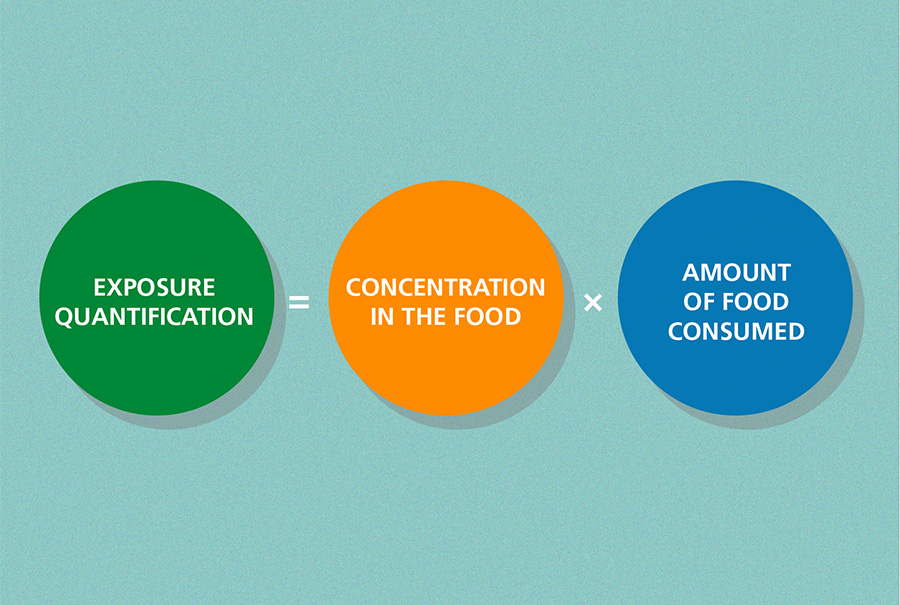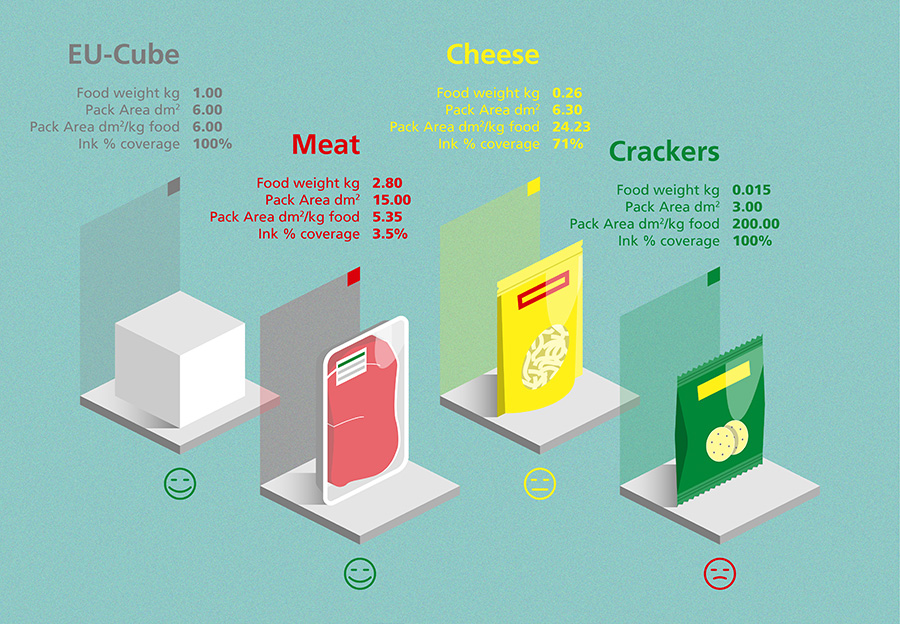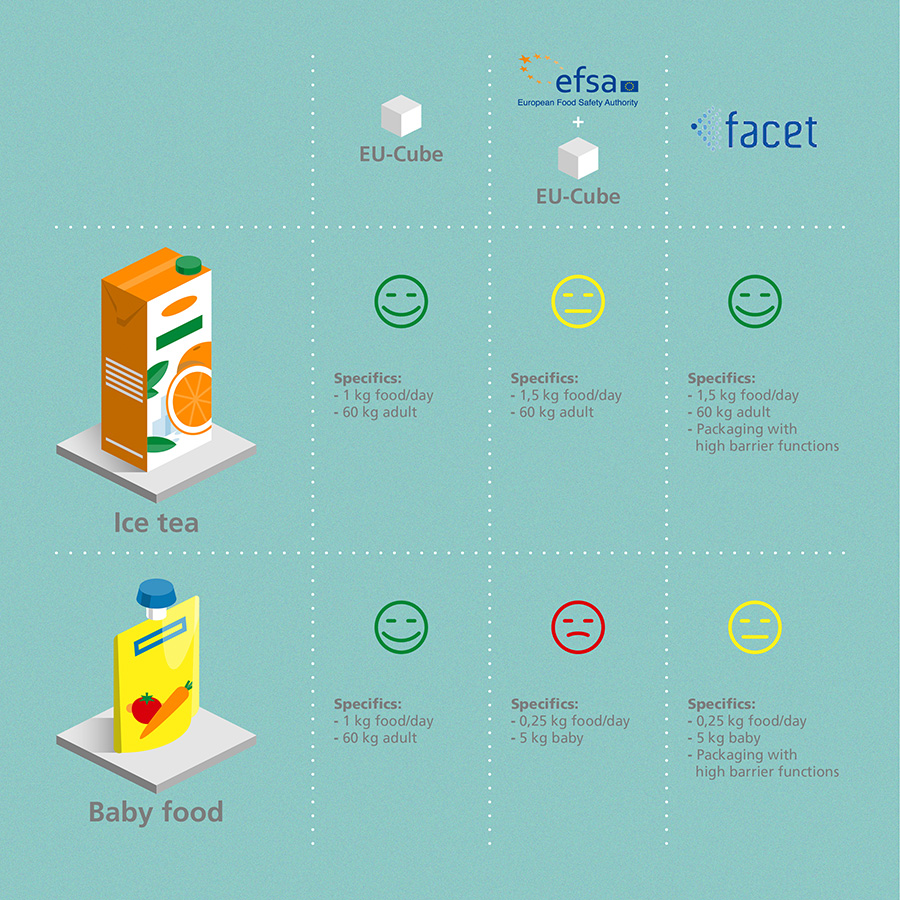Exposure Quantification
The exposure quantification is an essential part of a risk assessment. The risk assessment takes two important components into consideration: Hazard Characterization (dose–response-assessment) and Exposure Quantification.
The hazard characterization is a relationship between an administered dose of or exposure to a chemical substance and the incidence of an adverse health effect.
The exposure quantification could be necessary if migration of substances from printed food contact materials during migration testing might have been identified above a specific migration limit in food simulants. As identified concentration of substances in the foodstuff does not automatically mean harm for the consumer, the exposure quantification takes more parameters into account for an “advanced exposure assessment” to calculate the potential risk. The risk for consumers can be evaluated in combination with the hazard assessment for the identified substances (see also risk assessment).
Learn more about Siegwerk’s exposure quantification through our ePaper.
The “advanced exposure quantification” is based on:
- Concentration in the food: How much of the substance is in the food
- Amount of food consumed: How much of the food is likely to be consumed by the targeted consumers

In comparison to the “concentration in the food”, the “amount of food consumed” is the more variable parameter of the exposure quantification. Additionally, the outcome of the evaluation can be very different, depending on the consideration of the different parameters that can be taken into account for an exposure quantification.

For “concentration in the food” the main influencing parameters are:
- The type of packaging (e.g. which material (barrier behavior))
- The amount of packaging that comes into direct contact with the foodstuff (surface to volume ratio)
- The weight of the food
The influencing factors for “amount of food consumed” are the following:
- Which target groups are consuming the food, e.g. elderly, adults, adolescents, children, toddlers …
- The foodstuff itself and the amount that is consumed, for example bread or similar staple food is naturally consumed on a higher level compared to specialties.
- Geographical consumer behavior, e.g. regional differences in food consumption. For instance, in Switzerland the average chocolate consumption is double the EU average.
All of those parameters can be taken into account when it comes to calculating the exposure quantification. Which parameters are selected for exposure quantification only can be decided from case to case.
Exposure Quantification Models
Standard EU Cube Model
There are several models for exposure quantification. The most common model used in the EU is the default exposure quantification based on the standard EU cube model. It considers a 60kg adult that is consuming 1kg food per day, packed in a 6dm2 packaging (see worst case calculator).
This generic approach of the standard EU cube model and consumption data is an adequate method for most of the standard cases. But when a higher level of differentiation is needed the standard EU cube model might not be the right model to use.

The graphic shows that different packaging designs with regard to size, ink coverage and/or weight of the packed food can lead to different migration values for a certain migrant into the food compared to the corresponding SML (shown here by Smileys).
The generic approach for example does not consider the different consumer types with strongly divergent consumer characteristics. A baby for example is far more vulnerable to substance exposure compared to an adult. And an adult is for example consuming far more from a certain foodstuff compared to a child. But on the other hand, a child might consume more in relation to its bodyweight. This gives an impression how carefully the parameters need to be selected and how a more distinguished calculation of the exposure quantification can be essential to gain appropriate results.
Additionally, the EU model also does not include any data for the different regional consumption behavior and the packaging types used for the foodstuff.
In order to improve the outcome for a more distinguished calculation the model can be refined by using statistical consumer data bases. For instance, the EFSA consumption data base offers a wide range of statistical data for different food stuff, e.g. regional consumption differences or the typical consumption of different persona types (children, adolescents, adults...).
The EFSA model still does not include the packaging type and size for its calculation which can be a critical parameter to calculate the concentration of a substance in the food.
FACET
The FACET program is a software to estimate consumers' exposure to substances that can migrate from food contact materials into food. It contains databases of chemical concentrations for food flavorings and food additives, industry data on retail packaging composition, chemical occurrence data or their prediction, and food consumption diaries, which are then combined into probabilistic dietary exposure models. The model offers a variety of different tools, including migration modeling and exposure modeling. An advantage compared to the EU standard model is the capability to include different packaging data for its calculation, such as:
- Surface/volume ratio and different pack types
- Structures used in pack types
- Substances used in food contact materials
Conclusion
In many cases the exposure quantification as tier 4 is even not required. If it is required it always depends from case to case which exposure quantification model is the right one to use. It also needs to be differentiated if exposure quantification is conducted for a variety of packaging or a “specific packaging case”.
If exposure quantification is being carried out on a variety of packaging, it is crucial which parameters are being selected for the further investigation as they can all influence the final results of the calculation. Who is consuming the food, in which amounts is the food likely to be consumed, which packaging material is used (due to the different barrier effects), how large is the printed area of the packaging, what foodstuff does it contain (dry or fatty food), are broad statistical data available or is it a very specific packaging case? There are many different parameters that need to be carefully selected.
Generally speaking, the standard EU model is adequate for a basic evaluation. If the requirements get more specific, e.g. for baby food, it is reasonable to use other parameters or a more specific model, such as FACET.

The graphic shows two examples with different exposure quantification models for different target groups. Depending on the parameters taken into account for calculations the result for a certain migrant could lead to different exposure quantifications (shown here by Smileys).

